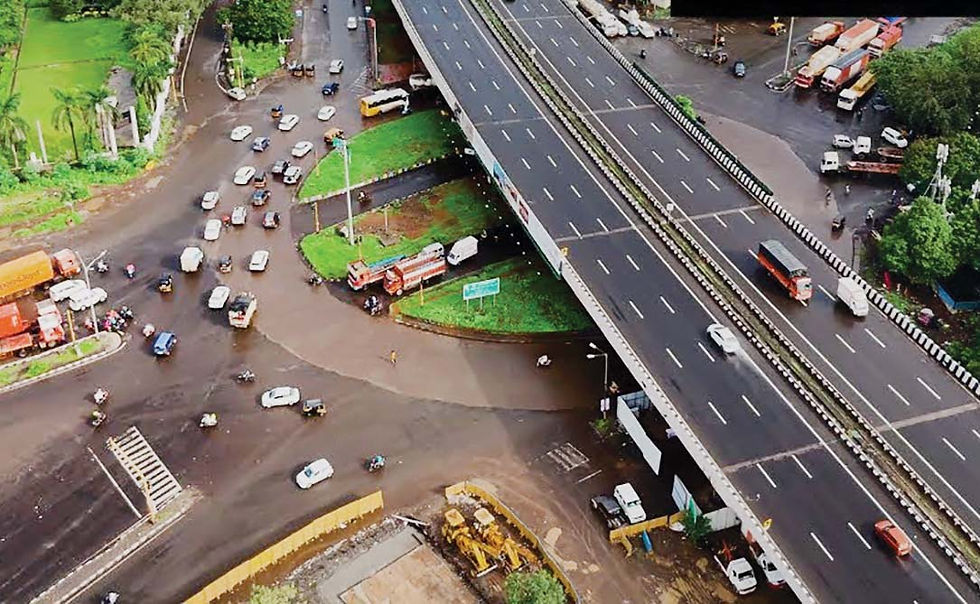Kalamboli Junction upgrade gathers pace
- Bhalchandra Chorghade
- Aug 11
- 3 min read
Rs 482-crore project targets seamless airport, port access

Mumbai: Work on the Rs 482-crore Kalamboli Junction Development Project, aimed at eliminating signals, easing congestion and boosting regional connectivity, is moving forward steadily, with key structural milestones already achieved. The National Highways Authority of India (NHAI) and Maharashtra State Infrastructure Development Corporation (MSIDC) are jointly executing the project, which is expected to transform one of Navi Mumbai’s busiest intersections into a high-speed, conflict-free traffic hub within 18 months.
On-site progress, engineering updates
According to an MSIDC official, 190 out of 688 piles have been completed, marking substantial advancement in foundation work. On the Pune ramp side, a 300-metre Pavement Quality Concrete (PQC) road and a 500-metre drainage system have been finished. Pile cap construction has commenced, while a casting yard for I-girder production has been set up, with the first girders expected to be cast by August 20.These developments indicate the project is well into its structural groundwork phase, a critical stage that determines the pace of superstructure assembly. Once girder casting begins, the visible transformation of the site is expected to accelerate, providing commuters with tangible signs of progress.
A two-level interchange to end traffic chaos
The upgraded junction will adopt a two-level directional/stack interchange design, ensuring signal-free movement and eliminating at-grade cross-conflicts — a major cause of delays at the current roundabout. The design aims to reduce queuing delays for all routes, an essential improvement given Kalamboli’s role as a convergence point for multiple arterial corridors.
These flyover arms will form the core of the project:
1. Shil Phata → Steel Yard
2. Pune → Shil Phata
3. Pune → Mumbai
4. Panvel → Mumbai
5. JNPA → Pune
6. Shil Phata → Pune
Additionally, two underpasses will link Panvel to Shil Phata and Panvel to the Steel Yard, further reducing traffic interference.
Strategic importance: Gateway to airport and port
Kalamboli Junction is not just a local traffic hotspot, it is a crucial node for Mumbai-Pune highway users, cargo transporters bound for Jawaharlal Nehru Port Authority (JNPA) and future passengers heading to the Navi Mumbai International Airport.Union Minister for Road Transport and Highways, Nitin Gadkari, had emphasised the importance of the upgrade, citing the junction’s pivotal role in both passenger mobility and freight logistics. With the airport slated to be a major regional hub, seamless access from major highways is considered vital for operational efficiency.
Managing disruptions during construction
While the long-term benefits are widely acknowledged, the project’s execution has inevitably brought short-term inconveniences. The Panvel exit from Kalamboli has been closed for six months, prompting traffic diversions via Palaspe and Atal Setu. This has led to heavier volumes on alternative routes, particularly during peak hours.Three piling rigs are operating round-the-clock to stay on schedule, with MSIDC and NHAI coordinating traffic management efforts. Officials are urging commuters to plan their journeys in advance and allow extra travel time.
Economic and urban mobility benefits
Once operational, the redesigned junction is expected to:
Cut travel time between Mumbai, Pune, and JNPA significantly.
Enhance logistics efficiency for cargo movement, reducing transit delays.
Improve accessibility to the Navi Mumbai International Airport, which will be a major driver of economic activity in the region.
Reduce fuel wastage and vehicular emissions by eliminating prolonged idling at signals.
Given that Kalamboli handles thousands of vehicles daily, including a high proportion of freight carriers, the project’s economic multiplier effect is likely to extend well beyond Navi Mumbai. Improved connectivity is expected to attract industrial and commercial investments to the surrounding zones, including Taloja, Panvel and Kharghar.
Challenges ahead
Despite the steady progress, certain challenges remain. Foundation work for the remaining 498 piles must be executed on time to avoid cascading delays in superstructure erection. Land acquisition for approaches and coordination with utility providers for shifting lines will also be critical to maintaining the schedule. Additionally, weather-related disruptions during the monsoon season could test construction timelines.However, the presence of a dedicated casting yard and pre-scheduled girder production indicates that MSIDC is aiming to offset potential delays by front-loading key fabrication work.
A transformational leap in regional transport
The Kalamboli Junction upgrade represents more than just an infrastructure project — it is a strategic urban mobility intervention. By combining flyovers, underpasses and a signal-free interchange, the design addresses not only current traffic bottlenecks but also anticipates future demand from Navi Mumbai’s urban expansion and the airport’s operations.If completed on schedule, by late 2026 commuters could see one of the most significant overhauls of a traffic node in Navi Mumbai’s history. As the first girders are cast this month, the groundwork is being laid — quite literally — for a faster, safer and more efficient transport experience across one of India’s busiest logistics and travel corridors.





Comments